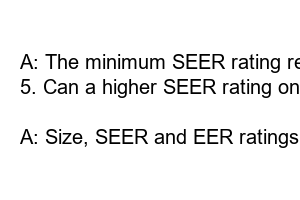에어컨 평수 계산
The calculation behind air conditioner rating may seem complex, but understanding it is essential for choosing the right AC unit for your home. The rating of an air conditioner is measured by its Seasonal Energy Efficiency Ratio (SEER) and Energy Efficiency Ratio (EER). In this blog, we’ll break down the math behind these ratings and help you make an informed decision when buying an air conditioner.
What is SEER?
Seasonal Energy Efficiency Ratio (SEER) determines the cooling efficiency of an air conditioner over an entire season. It is calculated by dividing the cooling capacity of the unit by its energy consumption measured in watt-hours. The higher the SEER, the more energy-efficient the unit and the lower your energy bills will be.
What is EER?
Energy Efficiency Ratio (EER) measures the cooling capacity of an air conditioner at a specific temperature. EER is calculated by dividing the unit’s cooling output by its energy input, both measured in watts. The higher the EER, the more efficient the unit will be at cooling your home.
How to calculate SEER and EER?
To calculate SEER, you need to divide the total cooling output of the air conditioning unit over a cooling season by its total energy consumption during that time.
SEER = Total cooling output / Total energy consumption
To calculate EER, you need to divide the cooling output of the AC unit by its energy consumption at a specific temperature.
EER = Cooling output / Energy consumption at a given temperature
What SEER and EER rating should I look for?
The minimum SEER rating required by the U.S. Department of Energy is 13. However, higher SEER ratings can provide better energy efficiency and cost savings. Look for a SEER rating of 14 or higher for the best energy savings. It’s recommended to have an EER of at least 11.6 for optimal cooling efficiency.
Factors that influence SEER and EER
Several factors can impact the SEER and EER ratings of an air conditioner, including the unit size, ductwork, insulation, and location. A well-maintained air conditioner with the right size and installation location can improve your unit’s SEER and EER ratings.
Conclusion
When purchasing an air conditioner, understanding its SEER and EER ratings is crucial in ensuring energy efficiency and cost savings. Higher SEER and EER ratings provide better cooling efficiency and lower energy bills. Ensure that you purchase the right size and maintain it regularly to help improve your unit’s ratings.
Frequently Asked Questions (FAQs)
1. What is a good SEER rating for an air conditioner?
A: A good SEER rating for an air conditioner is 14 or higher.
2. What is a good EER rating for an air conditioner?
A: A good EER rating for an air conditioner is at least 11.6.
3. What affects the SEER and EER ratings of an air conditioner?
A: The size, ductwork, insulation, and location of an air conditioner can affect its SEER and EER ratings.
4. What is the minimum SEER rating required by the U.S. Department of Energy?
A: The minimum SEER rating required by the U.S. Department of Energy is 13.
5. Can a higher SEER rating on an air conditioner save me money?
A: Yes, a higher SEER rating on an air conditioner can save you money on energy bills.
6. What factors should I consider when buying an air conditioner?
A: Size, SEER and EER ratings, installation location, and maintenance are essential factors to consider when buying an air conditioner.

